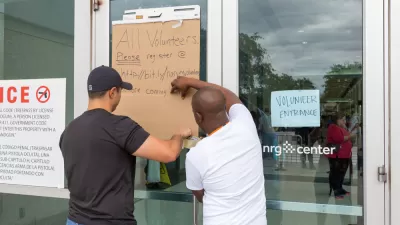In an opinion piece for Bloomberg View, Edward Glaeser argues that the Army Corps of Engineers' influence on development in local communities is too far-reaching.
News that the U.S. Army Corps of Engineers recently approved the construction of a garbage transfer station to be located in Manhattan's Upper East Side, inspired Glaeser's screed against the Corps' authority. Argues Glaeser, "We need a system where the Army Corps is confined to providing engineering expertise and transportation funding, in the same way that federal school spending is tied to performance."
Glaeser doesn't necessarily oppose programs put in place by the Corps, but he isn't keen on the idea that they are running the show, and claims local stakeholders have better know-how to evaluate projects' possible impacts. A prime example of the Corps' deficiencies, he writes, was the flood system that failed during Hurricane Katrina. For Glaeser the lesson learned from New Orleans is that, "The delegation of responsibility to a remote authority seems sure to create future disasters."
He emphasizes the importance of comprehensiveness in project approvals, and believes that agencies like the Army Corps and the EPA are vital to the process, but should not be given final authority. "Let the EPA evaluate the environmental consequences of infrastructure," he says, "but then ensure that final decision-making power sits with a body that will consider more than just the environment."
FULL STORY: Why Is the Army Corps Ruling Your Neighborhood?

Study: Maui’s Plan to Convert Vacation Rentals to Long-Term Housing Could Cause Nearly $1 Billion Economic Loss
The plan would reduce visitor accommodation by 25,% resulting in 1,900 jobs lost.

North Texas Transit Leaders Tout Benefits of TOD for Growing Region
At a summit focused on transit-oriented development, policymakers discussed how North Texas’ expanded light rail system can serve as a tool for economic growth.

Why Should We Subsidize Public Transportation?
Many public transit agencies face financial stress due to rising costs, declining fare revenue, and declining subsidies. Transit advocates must provide a strong business case for increasing public transit funding.

How to Make US Trains Faster
Changes to boarding platforms and a switch to electric trains could improve U.S. passenger rail service without the added cost of high-speed rail.

Columbia’s Revitalized ‘Loop’ Is a Hub for Local Entrepreneurs
A focus on small businesses is helping a commercial corridor in Columbia, Missouri thrive.

Invasive Insect Threatens Minnesota’s Ash Forests
The Emerald Ash Borer is a rapidly spreading invasive pest threatening Minnesota’s ash trees, and homeowners are encouraged to plant diverse replacement species, avoid moving ash firewood, and monitor for signs of infestation.
Urban Design for Planners 1: Software Tools
This six-course series explores essential urban design concepts using open source software and equips planners with the tools they need to participate fully in the urban design process.
Planning for Universal Design
Learn the tools for implementing Universal Design in planning regulations.
City of Santa Clarita
Ascent Environmental
Institute for Housing and Urban Development Studies (IHS)
City of Grandview
Harvard GSD Executive Education
Toledo-Lucas County Plan Commissions
Salt Lake City
NYU Wagner Graduate School of Public Service



























